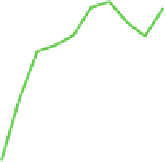Civil Engineering Reference
In-Depth Information
Fig. 5.46 CTD-SST around the wind farm
alpha ventus
in three different presentations to
exemplify surface temperature field along sections
West
(
yellow
),
South
(
green
),
East
(
red
),
'
'
'
'
'
'
and
s position. The
upper left figure
illustrates SST for each section. The
lower left figure
accents temperature differences around the
wind farm. The
right figure
helps to get a spatial idea of SST distribution. The cube
North
(
blue
).
Gray bars
mark the section of the wind farm
'
'
'
s
z
-axis gives
temperature in
C, starting with 7
C and ending with 8.2
C.
X
-axis and
y
-axis reflect CTD
numbers, respectively position
'
east and then the modeled SSTs along that square (in Fig.
5.47c
) fits quite well the
measured SSTs in Fig.
5.46
. Along that new square, the modeled SSTs show a drop
in SST along the west section, common lower SSTs in the north, higher values in
the section of the OWF at the east section, and the maximum of increased SSTs
along the south section. The new square (Fig.
5.47c
) counts in the north and east a
distance to the OWF center of 12 km, in the south only 3 km, in the west 15 km and
comprises a 2.8 times greater area than the
which means in
x
-direction the dimension of the simulated temperature effect is overestimated by
factor 1.75, in
y
-direction by factor 1.25, compared to observations. In average, the
differences between observed SST along
6 km-distance square,
'
'
6 km-distance square
and simulated SST
'
'
along the greater square count 0.20
C.
The modification of the square around the OWF for comparison is not performed
arbitrarily but is based on known computational restrictions—here, the horizontal
resolution of the wake presentation. Apart from that, the model captures the
observed temperature structures.
At the corners of that square, a cooling is observed with the exception of the
southeast corner. The fact that the corners show a cooling result in the assumption









































































































































































































































































































































































































































































































































































































































































































































































































































































































































































































































































































































































































































































































































































































































































































































































































































































































































































































































































































































































































































































































































































































































































































































































































































































































































































































































































































































































































































































































































































































































































































































































































































































































































































































































































































































































































































































































































































































































































































































































































































































































































































































































































































































































































































































































































































































































































































































































































































































































































































































































































































































































































































































































































































































































































































































































































































































































































































































































































































































































































































































































































































































































































































































































































































































































































































































































































































































































































































































































































































































































































































































































































































































































































































































































































































































































































































































































































































































































































































































































































































































































































































































































































































































































































































































































































Search WWH ::

Custom Search